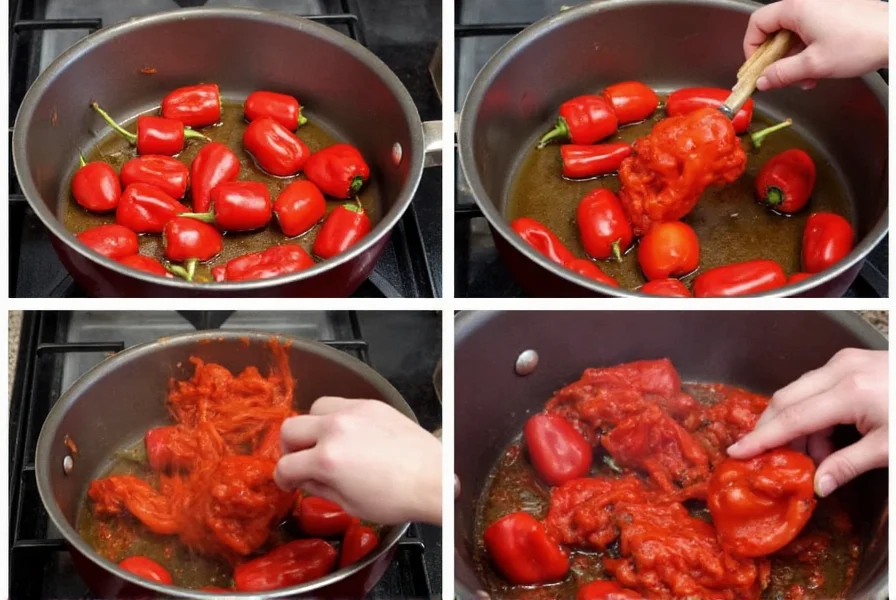Creating the perfect roasted pepper sauce requires understanding both technique and flavor balance. This guide explores authentic preparation methods, ingredient variations, and culinary applications that transform simple roasted peppers into a restaurant-quality sauce you can make at home.
The Essential Components of Roasted Pepper Sauce
While recipes vary by region and personal preference, all exceptional roasted pepper sauces share these foundational elements:
- Pepper selection - Red bell peppers provide sweetness, while poblano or Anaheim peppers add mild heat
- Proper charring technique - Achieving blistered skin without burning the flesh
- Acid component - Vinegar or lemon juice for brightness and preservation
- Emulsifying agent - Olive oil creates smooth texture and carries flavors
- Aromatic base - Garlic, shallots, or onions enhance depth
- Seasoning balance - Salt, herbs, and optional spices like smoked paprika

Step-by-Step Preparation Guide
Follow this professional technique for consistently excellent results:
- Prepare peppers - Wash 4 large red bell peppers, remove stems and seeds
- Char the peppers - Place directly over gas flame or under broiler, turning until completely blackened (8-10 minutes)
- Sweat the peppers - Transfer to covered bowl for 10 minutes to loosen skins
- Peel carefully - Remove charred skin under running water, preserving pepper flesh
- Blend ingredients - Combine peppers with 2 garlic cloves, 1/4 cup olive oil, 2 tbsp vinegar, salt, and optional spices
- Adjust consistency - Add water or more oil until reaching desired thickness
- Rest before serving - Refrigerate for 2 hours to allow flavors to meld
Variations for Different Culinary Applications
Tailor your roasted pepper sauce for specific dishes with these professional variations:
| Variation Type | Key Modifications | Best Paired With |
|---|---|---|
| Classic Spanish Romesco | Add toasted almonds, breadcrumbs, tomato paste | Grilled fish, roasted vegetables |
| Smoky Chipotle Version | Substitute 1-2 chipotle peppers in adobo | Tacos, burritos, grilled meats |
| Creamy Pasta Sauce | Add 1/4 cup heavy cream or cashew cream | Fresh pasta, gnocchi, stuffed shells |
| Spicy Arrabbiata Style | Add red pepper flakes, extra garlic | Meatballs, pizza, hearty sandwiches |
Professional Tips for Perfect Results
Master these techniques to elevate your homemade roasted pepper sauce:
- Skin removal matters - Don't rush the sweating process; properly loosened skin comes off easily without losing pepper flesh
- Temperature control - Blend ingredients while peppers are still slightly warm for smoother emulsion
- Acid balance - Add vinegar gradually; too much creates harshness that overwhelms pepper sweetness
- Texture customization - For dipping, keep slightly chunky; for pasta, blend until completely smooth
- Flavor development - Refrigerate overnight for significantly improved complexity
Storage and Shelf Life Guidelines
Proper storage maintains both safety and flavor quality:
- Refrigerate in airtight container for up to 1 week
- Freeze in ice cube trays then transfer to freezer bags for up to 6 months
- Always use clean utensils when serving to prevent contamination
- Acidic versions (with more vinegar) last longer than creamy variations
- Discard if mold appears or if unpleasant odor develops
Common Mistakes to Avoid
Even experienced cooks make these errors when preparing roasted pepper sauce:
- Insufficient charring - Peppers need complete blackening for proper flavor development
- Over-blending - Creates heat that breaks down delicate pepper compounds
- Skipping the resting period - Flavors need time to integrate for optimal taste
- Using watery peppers - Some varieties contain too much moisture, diluting flavor
- Adding salt too early - Can draw out moisture and affect texture
Nutritional Benefits
Beyond its culinary versatility, roasted pepper sauce offers notable health advantages:
- Rich in vitamin C (one red bell pepper contains more than an orange)
- Contains antioxidants like carotenoids and flavonoids
- Healthy fats from olive oil enhance nutrient absorption
- Naturally low in calories (approximately 40-60 calories per 1/4 cup)
- Provides dietary fiber that supports digestive health
Frequently Asked Questions
Can I use jarred roasted peppers instead of fresh?
Yes, but drain them thoroughly and reduce added liquid in your recipe. Freshly roasted peppers provide superior flavor complexity, but high-quality jarred peppers work in a pinch. Look for peppers packed in water rather than oil for better control of your sauce's texture.
Why does my roasted pepper sauce separate?
Separation occurs when the emulsion breaks, usually from insufficient blending or improper oil-to-pepper ratio. To fix this, slowly drizzle in additional olive oil while blending, or add a small amount of bread or nuts which help stabilize the emulsion. For immediate use, vigorous whisking can temporarily recombine the ingredients.
What's the best way to achieve smoky flavor without charring?
If you don't have access to open flame, use your broiler on high for 5-7 minutes per side. For authentic smokiness without charring, add 1/4 teaspoon smoked paprika or a small piece of chipotle pepper. Liquid smoke works in small quantities (1/8 teaspoon) but use sparingly as it can dominate other flavors.
How can I adjust the heat level in roasted pepper sauce?
Control heat by selecting appropriate peppers: bell peppers for mild sauce, poblano for medium heat, or add jalapeño for spiciness. Remove seeds and white membranes for less heat. For finished sauce that's too spicy, balance with additional roasted peppers, a touch of honey, or dairy like yogurt. Remember that heat perception intensifies slightly when refrigerated.
What dishes work best with roasted pepper sauce as a base?
Roasted pepper sauce serves as an excellent foundation for numerous dishes including pasta sauces (especially with added cream), pizza bases, shakshuka, stuffed vegetables, and as a marinade for chicken or fish. It also enhances grain bowls, roasted vegetable toppings, and sandwich spreads. For pasta dishes, thin with pasta water to help the sauce adhere properly to noodles.











 浙公网安备
33010002000092号
浙公网安备
33010002000092号 浙B2-20120091-4
浙B2-20120091-4